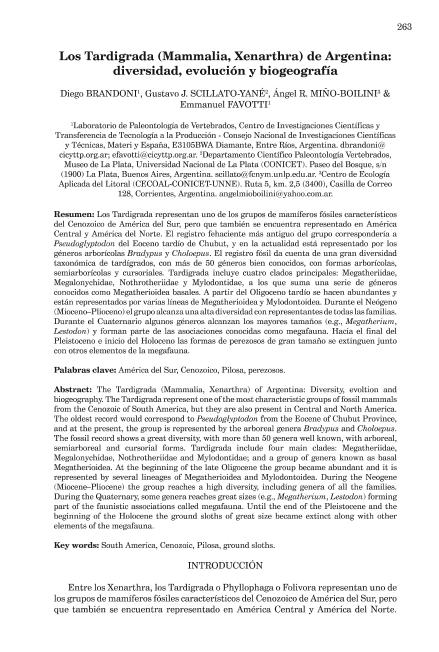Artículo
Los Tardigrada representan uno de los grupos de mamíferos fósiles característicos del Cenozoico de América del Sur, pero que también se encuentra representado en América Central y América del Norte. El registro fehaciente más antiguo del grupo correspondería a Pseudoglyptodon del Eoceno tardío de Chubut, y en la actualidad está representado por los géneros arborícolas Bradypus y Choloepus. El registro fósil da cuenta de una gran diversidad taxonómica de tardígrados, con más de 50 géneros bien conocidos, con formas arborícolas, semiarborícolas y cursoriales. Tardigrada incluye cuatro clados principales: Megatheriidae, Megalonychidae, Nothrotheriidae y Mylodontidae, a los que suma una serie de géneros conocidos como Megatherioidea basales. A partir del Oligoceno tardío se hacen abundantes y están representados por varias líneas de Megatherioidea y Mylodontoidea. Durante el Neógeno (Mioceno–Plioceno) el grupo alcanza una alta diversidad con representantes de todas las familias. Durante el Cuaternario algunos géneros alcanzan los mayores tamaños (e.g., Megatherium, Lestodon) y forman parte de las asociaciones conocidas como megafauna. Hacia el final del Pleistoceno e inicio del Holoceno las formas de perezosos de gran tamaño se extinguen junto con otros elementos de la megafauna. The Tardigrada represent one of the most characteristic groups of fossil mammals from the Cenozoic of South America, but they are also present in Central and North America. The oldest record would correspond to Pseudoglyptodon from the Eocene of Chubut Province, and at the present, the group is represented by the arboreal genera Bradypus and Choloepus. The fossil record shows a great diversity, with more than 50 genera well known, with arboreal, semiarboreal and cursorial forms. Tardigrada include four main clades: Megatheriidae, Megalonychidae, Nothrotheriidae and Mylodontidae; and a group of genera known as basal Megatherioidea. At the beginning of the late Oligocene the group became abundant and it is represented by several lineages of Megatherioidea and Mylodontoidea. During the Neogene (Miocene–Pliocene) the group reaches a high diversity, including genera of all the families. During the Quaternary, some genera reaches great sizes (e.g., Megatherium, Lestodon) forming part of the faunistic associations called megafauna. Until the end of the Pleistocene and the beginning of the Holocene the ground sloths of great size became extinct along with other elements of the megafauna.
Los Tardigrada (Mammalia, Xenarthra) de Argentina: Diversidad, evolución y biogeografía
Título:
The Tardigrada (Mammalia, Xenarthra) of Argentina: Diversity, evoltion and biogeography
Fecha de publicación:
04/2016
Editorial:
Museo Argentino de Ciencias Naturales "Bernardino Rivadavia"
Revista:
Contribuciones del MACN
ISSN:
1666-5503
Idioma:
Español
Tipo de recurso:
Artículo publicado
Clasificación temática:
Resumen
Palabras clave:
América del Sur
,
Pilosa
,
Cenozoico
,
Perezosos
Archivos asociados
Licencia
Identificadores
Colecciones
Articulos(CECOAL)
Articulos de CENTRO DE ECOLOGIA APLICADA DEL LITORAL (I)
Articulos de CENTRO DE ECOLOGIA APLICADA DEL LITORAL (I)
Articulos(CICYTTP)
Articulos de CENTRO DE INV.CIENT.Y TRANSFERENCIA TEC A LA PROD
Articulos de CENTRO DE INV.CIENT.Y TRANSFERENCIA TEC A LA PROD
Citación
Brandoni, Diego; Scillato Yané, Gustavo J.; Miño Boilini, Ángel Ramón; Favotti, Sergio Emmanuel; Los Tardigrada (Mammalia, Xenarthra) de Argentina: Diversidad, evolución y biogeografía; Museo Argentino de Ciencias Naturales "Bernardino Rivadavia"; Contribuciones del MACN; 6; 4-2016; 263-274
Compartir




